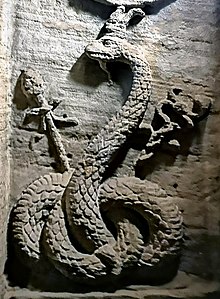Agathodaemon
| Agathos Daimon | |
|---|---|
Fertility, grain, health | |
 | |
| Major cult centre | Alexandria, Egypt |
| Animals | Snakes |
| Symbol | Horn of Plenty |
| Day | 2 February (Gregorian) 25 Tybi (Egyptian) |
| Gender | Male |
| Consort | Tyche Agathe |
| Equivalents | |
| Pre-Ptolemaic Egyptian | Shai |
Agathos Daimon (ἀγαθός δαίμων, agathós daímōn, lit. 'noble spirit')[a] originally was a lesser deity (daemon) of classical ancient Greek religion and Graeco-Egyptian religion. In his original Greek form, he served as a household god, to whom, along with Zeus Soter, libations were made after a meal. In later Ptolemaic antiquity he took on two partially distinct roles; one as the Agathos Daimon a prominent serpentine civic god, who served as the special protector of Alexandria. The other as a genus of serpentine household gods, the Agathoi Daimones, individual protectors of the homes in which they were worshipped.[1]
Early history
[edit]Agathos Daimon was attested in domestic context in Greece as early as the fifth century BC, and yet he was typically not represented there in the form of a snake, as opposed to in Alexandria, where he was abundantly so represented.[2]
- "His origin in Alexandria is a matter of dispute, with two conflicting views either painting Agathos Daimon as a Greek cultural importation later identified with Serapis and with Egyptian gods Šai (Shai), Knephis (Kneph), Khnum, Soknopis,[3] or as a Hellenized native Egyptian household god.[4] Quaegebeur points out the near absence of Greek sources of the Ptolemaic age for the cult of Agathos Daimon, contrasted with the abundance of Egyptian attestations of the god Šai in this age and the poignant evidence of the Oracle of the Potter ..."[5]
The Oracle of the Potter, an Egyptian nationalistic text, predicted the coming doom of Alexandria, with the local gods Knephis (also often represented as a serpent) and Agathos Daimon leaving the city for Memphis, and the defeat of the Macedonian invaders, and their 'age of chaos'.
Greek classical period
[edit]Though he is noted in Greek mythology (Pausanias conjectured that the name was merely an epithet of Zeus),[6] it was customary to drink or pour out a few drops of unmixed wine to honor the Agathos Daimon after a meal.[7][8] In Aristophanes' Peace, when War has trapped Peace (Εἰρήνη Eirene) in a deep pit, Hermes comes to give aid: "Now, oh Greeks! is the moment when, freed of quarrels and fighting, we should rescue sweet Eirene and draw her out of this pit... This is the moment to drain a cup in honor of the Agathos Daimon." A temple dedicated to them was situated on the road from Megalopolis to Maenalus in Arcadia.[9]
Agathos Daimon was the spouse or companion of Tyche Agathe (Τύχη Ἀγαθή, "Good Fortune"). "Tyche we know at Lebadeia as the wife of the Agathos Daimon, the Good or Rich Spirit".[10][11] Their numinous presence could be represented in art as a serpent or more concretely as a young man bearing a cornucopia and a bowl in one hand, and a poppy and an ear of grain in the other.[10]

Agathos Daimon was also identified with Zeus Meilichios, as well as with Serapis.[12]
In Egypt, a similar deity was Shai, who was known as the god of fate. His worship went back as far as the time of Akhenaten in the New Kingdom.
Egyptian late antiquity
[edit]
In the syncretic atmosphere of late Antiquity, agathodaemons could be bound up with Egyptian bringers of security and good fortune: a gem carved with magic emblems bears the images of Serapis with crocodile, sun-lion and Osiris mummy surrounded by the lion-headed snake Chnum–Agathodaemon–Aion, with Harpocrates on the reverse.[13]
See also
[edit]Footnotes
[edit]- ^ Sometimes written as Agathodaemon (Ancient Greek: ἀγαθοδαίμων, agathodaímōn)
References
[edit]- ^ Ogden, Daniel (2013). Drakōn : dragon myth and serpent cult in the Greek and Roman worlds. Oxford University Press. pp. 286–309. ISBN 978-0-19-955732-5. OCLC 837855776.
- ^ Krzysztof Nawotka, The Alexander Romance by Ps.-Callisthenes: A Historical Commentary, [2017], pp.106-8; (cited in earlywritings.com, 2023)
- ^ For this view see: Fraser, P.M. 1972. Ptolemaic Alexandria, Vols i–iii. Oxford. i, 209–212
- ^ Quaegebeur, J. 1975. Le dieu égyptien Shaï dans la religion et l’onomastique. Leuven. pp. 170–176
- ^ Krzysztof Nawotka, The Alexander Romance by Ps.-Callisthenes: A Historical Commentary, [2017], pp.106-8; (cited in earlywritings.com, 2023)
- ^ Pausanias, Description of Greece, viii. 36. § 3
- ^ Martin P. Nilsson, Greek Folk Religion. (Columbia University Press), 1981:33, 70, 73.
- ^ Fraser, Peter M. (1972). Ptolemaic Alexandria. Vol. I. Oxford: Claredon Press. p. 210.
- ^ Schmitz, Leonhard (1867), "Agathodaemon", in Smith, William (ed.), Dictionary of Greek and Roman Biography and Mythology, vol. 1, Boston, p. 65, archived from the original on 2005-10-26, retrieved 2008-05-05
{{citation}}: CS1 maint: location missing publisher (link) - ^ a b Chisholm 1911, p. 371.
- ^ Harrison 1922, pp. 355–ff, 543.
- ^ João Pedro Feliciano 2016, The Agathos Daimon in Greco-Egyptian religion. The Hermetic Tablet: The Journal of Ritual Magic 3 (2016), 171–92
- ^ Illustrated in W. Fauth, Helios Megistos: zur synkretistischen Theologie der Spätantike (Leiden: Brill) 1995:85.
- This article incorporates text from a publication now in the public domain: Chisholm, Hugh, ed. (1911). "Agathodaemon". Encyclopædia Britannica. Vol. 1 (11th ed.). Cambridge University Press. p. 371.
Bibliography
[edit]- Harrison, Jane Ellen (1922). Prolegomena to the Study of Greek Religion (3rd ed.). pp. 355–ff, 543.
External links
[edit]Lua error in Module:Navbox at line 192: attempt to concatenate field 'argHash' (a nil value).
